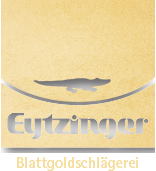How do you calculate the gold leaf requirement correctly?
In the case of larger projects and gilding jobs, correctly calculating the precise gold leaf requirement is a difficult balancing act. Either you calculate the gold leaf requirement generously and end up with leftover material, or you run short on gold leaf and get held up in the middle of the project. As a rule, it is therefore worth adopting a very structured approach and answering a few questions before beginning the project.
What is the gold leaf requirement then?
The surface area determines how much gold leaf is required
- Smooth surfaces: 180 leaves in the format 80 x 80 mm / 1 m²
- Textured surfaces: 250 – 300 leaves / 1 m ²
- Very textured surfaces: 300 – 700 leaves / 1 m ²
With which gold leaf would / can you work?
As a rule, from a certain project size everything must be scrutinised. The most important question should be this: how can work time, material and staffing costs be cut down? Most gilders are used to working with a standard 80 x 80 mm gold leaf format. Alternatively, we can produce larger gold leaf formats of up to 120 x 120 mm for you.
- Rectangular gold leaf formats, such as 70 x 90 mm, can be custom made to suit your surfaces. Cutting gold leaf on a gilder’s pad or as transfer gold results in wasted time and higher staffing costs. With a rectangular gold leaf format, you might save gilding time and reduce material losses.
- Gold leaf on rolls can be an enormous time-saver when gilding round rods, hollow profiles and also smooth surfaces. Gold leaf on rolls is available in widths ranging from 10 mm to 100 mm. The roll length is 21 metres.
- Gold flakes are a huge help when working with ornamented surfaces. Before the surface is brushed and polished, additional flakes are scattered here and there. This ensures that there is sufficient gold leaf on the surface, and there will be no flaws in the dents of the gilded surface. Gold flakes can be produced in any desired colour, as required.
- Gold powder is an alternative in case of partial touch ups, fine lines and larger surfaces. Gold powder can be applied both to water gilded and oil gilded surfaces. Gold powder can be mixed into a varnish or adhesive solution. With this technology, the particle structure of gold powder is visible and the consumption of gold powder is considerably higher.


